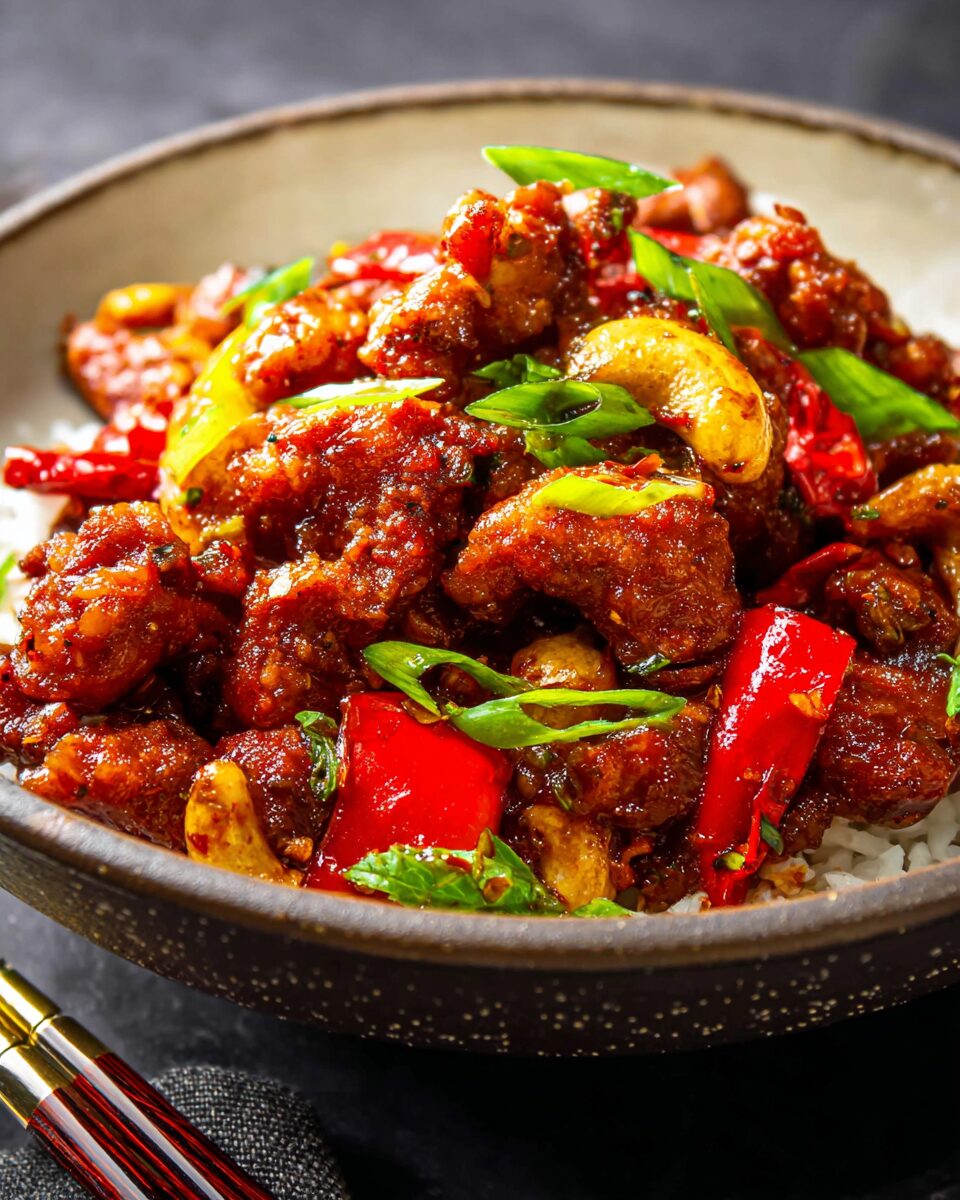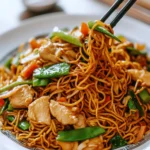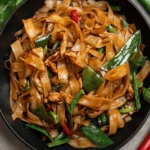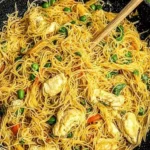This Dragon Chicken is a savory yet spicy delight with tender chicken coated in a sticky, sweet sauce infused with garlic, ginger, and a fiery kick from sriracha. Garnished with sesame seeds and green onions, it’s not only a treat for your taste buds but a feast for your eyes as well.
Whether you’re looking for a bold dinner option or a meal to impress guests, Dragon Chicken offers an exciting blend of flavors that will keep you coming back for more. Perfectly balanced with sweetness and heat, this dish is sure to become a favorite in your weekly rotation. Pair it with rice or your favorite stir-fry vegetables for a complete, flavorful meal.
Full Recipe:
-
1 lb chicken breast, cut into bite-sized pieces
-
1 tablespoon cornstarch
-
2 tablespoons vegetable oil
-
1/2 cup onion, chopped
-
1/2 cup bell pepper, chopped
-
3 cloves garlic, minced
-
1 tablespoon ginger, minced
-
1/4 cup soy sauce
-
1/4 cup rice vinegar
-
1/4 cup honey
-
2 tablespoons sriracha sauce
-
1 tablespoon hoisin sauce
-
1 tablespoon ketchup
-
1 tablespoon sesame oil
-
1 tablespoon sesame seeds
-
2 green onions, sliced for garnish
-
Salt and pepper to taste
Directions:
-
In a small bowl, toss the chicken pieces with cornstarch until coated.
-
Heat vegetable oil in a large skillet over medium-high heat. Add chicken pieces and cook for 5-7 minutes until browned and crispy. Remove and set aside.
-
In the same skillet, add the onion, bell pepper, garlic, and ginger. Sauté for 2-3 minutes until the vegetables are tender.
-
In a small bowl, whisk together soy sauce, rice vinegar, honey, sriracha, hoisin, ketchup, and sesame oil to create the sauce.
-
Pour the sauce into the skillet with the vegetables and bring to a simmer. Cook for 3-4 minutes, allowing the sauce to thicken.
-
Add the crispy chicken back into the skillet, stirring to coat in the sauce. Cook for an additional 2-3 minutes.
-
Garnish with sesame seeds and sliced green onions. Serve hot and enjoy!
Prep Time: 10 minutes | Cooking Time: 15 minutes | Total Time: 25 minutes
Kcal: 350 kcal | Servings: 4 servings
History and Origin
Dragon Chicken is a modern Chinese-inspired dish that plays on the traditional “chicken stir-fry” methods found in many Asian cuisines. While the exact origins of Dragon Chicken are not well-documented, it likely stems from the growing popularity of bold and spicy dishes in Chinese-American cuisine. The dish draws influences from Szechuan cuisine, which is known for its use of chili peppers, garlic, and bold, tangy sauces.
The term “Dragon” in Dragon Chicken is often associated with the fiery and spicy nature of the dish, symbolizing the dragon’s power and heat in Chinese culture. Many Chinese dishes that feature a combination of spice and sweetness are often named after the dragon to invoke strength, flavor, and boldness. This dish is a reflection of the creativity and fusion seen in modern Chinese cooking, blending both traditional flavors and contemporary preparation methods.
Variations and Adaptations
Dragon Chicken can be easily adapted to suit different tastes or dietary preferences, making it an extremely versatile dish. Below are a few ways to mix up the classic recipe:
-
Vegetarian Dragon Chicken: For those who prefer plant-based meals, tofu or tempeh can be substituted for chicken. The tofu or tempeh will absorb the sauce beautifully and provide a similar texture to chicken.
-
Gluten-Free Version: If you’re looking for a gluten-free alternative, simply substitute the soy sauce with tamari or a gluten-free soy sauce. Ensure that the hoisin sauce you use is also gluten-free, as many varieties contain wheat.
-
Spice Levels: The amount of sriracha used can be adjusted depending on your spice tolerance. If you prefer a milder version, reduce the sriracha or swap it with a milder hot sauce, such as a sweet chili sauce. For those who enjoy the heat, increase the amount of sriracha or add extra chili flakes for an added kick.
-
Sauce Variations: The sauce for Dragon Chicken is typically a mix of soy sauce, honey, sriracha, hoisin, and ketchup, but there’s room for creativity. For example, you could use maple syrup instead of honey for a different sweet note, or try adding a splash of rice wine vinegar to balance the flavors even more.
-
Regional Twists: In some parts of China, especially in Szechuan cuisine, there might be a variation of this dish where it is served with numbing spices like Sichuan peppercorns. This would add a unique flavor profile that pairs well with the heat of the sriracha.
Nutritional Information
Dragon Chicken can be a flavorful yet indulgent dish, so understanding its nutritional content is key for those mindful of their dietary intake. The nutritional value will vary depending on portion sizes, ingredients, and any modifications made to the recipe.
On average, one serving of Dragon Chicken contains about 350 calories. This makes it a moderate-calorie meal when served with vegetables or a side of rice. In terms of macronutrients, each serving typically contains:
-
Protein: Chicken breast is a high-protein food, with one serving of Dragon Chicken providing around 25-30 grams of protein, which is essential for muscle repair and overall body function.
-
Fat: The dish contains around 15 grams of fat, primarily from the vegetable oil used to fry the chicken and the sesame oil in the sauce. Most of these fats are healthy, unsaturated fats.
-
Carbohydrates: With about 25 grams of carbs per serving, Dragon Chicken is moderate in carbohydrates. The sugar content primarily comes from the honey and ketchup, providing some sweetness to balance the heat.
-
Fiber: Vegetables like bell peppers and green onions contribute a small amount of fiber, adding to the dish’s overall nutritional profile.
In terms of micronutrients, this dish is a good source of vitamins A and C, which come from the bell peppers and green onions. The sesame seeds also provide a decent amount of calcium and iron.
However, it’s important to note that the dish does contain some sodium from soy sauce, so those watching their sodium intake may want to opt for a low-sodium soy sauce or reduce the amount used.
Serving Suggestions and Pairings
Dragon Chicken is a vibrant dish that pairs wonderfully with various sides and accompaniments. Here are a few ideas for pairing:
-
Rice: Serve it over a bed of steamed jasmine rice, basmati rice, or even cauliflower rice for a low-carb alternative. The rice will absorb the delicious sauce, ensuring every bite is packed with flavor.
-
Stir-Fried Vegetables: A side of stir-fried vegetables such as bok choy, snap peas, and carrots would complement the spicy, tangy chicken perfectly, adding more color and nutrients to your meal.
-
Noodles: For an extra indulgent option, serve the chicken with stir-fried noodles or lo mein. The noodles will make a great base for the chicken and sauce.
-
Salads: A fresh cucumber and avocado salad with a light vinaigrette could provide a refreshing contrast to the rich and spicy chicken.
For drinks, pair the dish with something that can balance out the heat. A cold beer, such as a pilsner or pale ale, is a great match. Alternatively, a refreshing iced tea with a slice of lemon can help soothe the spiciness while adding a refreshing note to the meal.
Tips and Tricks for Success
To ensure your Dragon Chicken turns out perfectly, follow these tips:
-
Crisp the Chicken: Make sure the chicken is coated well in cornstarch before frying, as this will help it become crisp and golden brown. Avoid overcrowding the pan when frying, as this can cause the chicken to steam instead of fry.
-
Control the Sauce: The sauce is the star of this dish, so make sure to let it simmer long enough to thicken. If you want a thicker sauce, let it cook for a bit longer until it coats the back of a spoon.
-
Balance Sweet and Heat: Adjust the sriracha and honey to your taste preference. For a sweeter version, add a little more honey, or for more heat, increase the sriracha. Taste the sauce before adding it to the chicken to make sure it has the right balance for you.
-
Garnishing: Don’t skip the sesame seeds and green onions! These additions add both texture and visual appeal to the dish, making it look as good as it tastes.
Potential Health Benefits
Dragon Chicken contains several ingredients that offer potential health benefits:
-
Chicken: As a lean source of protein, chicken supports muscle building, immune function, and overall body repair. It’s also a good source of B vitamins like niacin and B6, which help with energy production.
-
Ginger: Ginger is known for its anti-inflammatory properties and can aid in digestion. It may also help reduce nausea and improve overall gut health.
-
Garlic: Garlic is packed with antioxidants and has long been praised for its potential to boost the immune system. It also contains compounds that may support heart health.
-
Bell Peppers: Rich in vitamins A and C, bell peppers are excellent for supporting skin health, immune function, and vision. They also contain antioxidants that help protect the body from free radicals.
Conclusion
Dragon Chicken is an exciting dish that combines bold flavors with an easy-to-make preparation. Whether you’re serving it to spice up a casual weeknight dinner or impressing friends at a gathering, this dish is sure to become a favorite. With its crispy chicken, sweet and spicy sauce, and fresh vegetables, Dragon Chicken delivers on both flavor and nutrition. So, why not give this recipe a try? Your taste buds will thank you!





